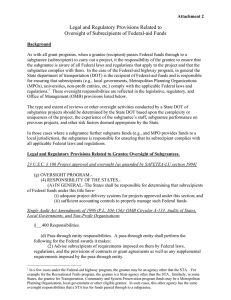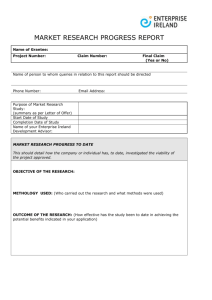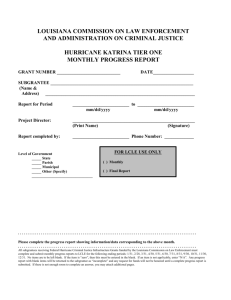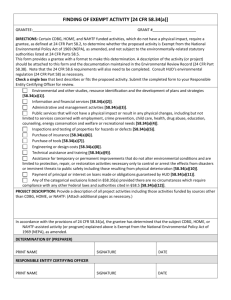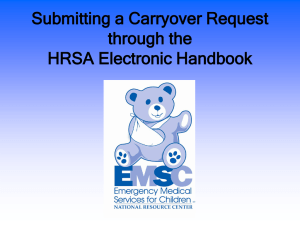Document 13404455
advertisement
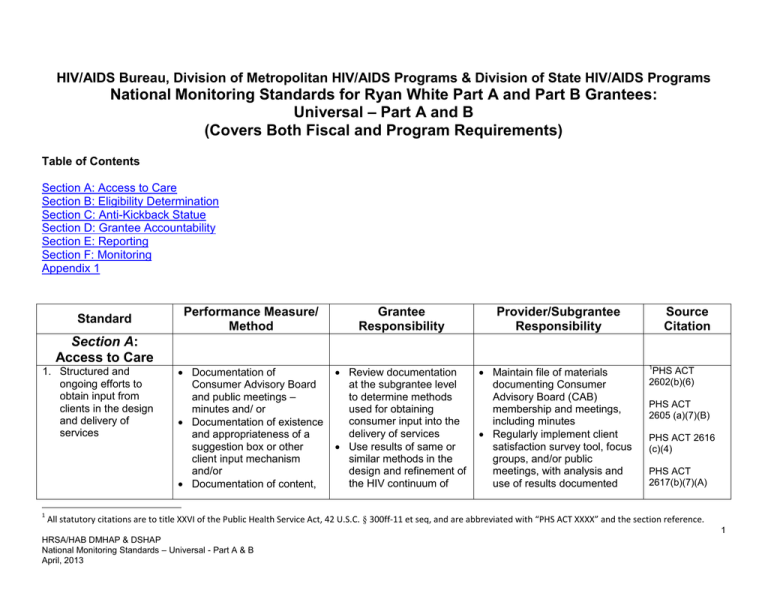
HIV/AIDS Bureau, Division of Metropolitan HIV/AIDS Programs & Division of State HIV/AIDS Programs National Monitoring Standards for Ryan White Part A and Part B Grantees: Universal – Part A and B (Covers Both Fiscal and Program Requirements) Table of Contents Section A: Access to Care Section B: Eligibility Determination Section C: Anti-Kickback Statue Section D: Grantee Accountability Section E: Reporting Section F: Monitoring Appendix 1 Standard Performance Measure/ Method Grantee Responsibility Provider/Subgrantee Responsibility Documentation of Consumer Advisory Board and public meetings – minutes and/ or Documentation of existence and appropriateness of a suggestion box or other client input mechanism and/or Documentation of content, Review documentation at the subgrantee level to determine methods used for obtaining consumer input into the delivery of services Use results of same or similar methods in the design and refinement of the HIV continuum of Maintain file of materials documenting Consumer Advisory Board (CAB) membership and meetings, including minutes Regularly implement client satisfaction survey tool, focus groups, and/or public meetings, with analysis and use of results documented Source Citation Section A: Access to Care 1. Structured and ongoing efforts to obtain input from clients in the design and delivery of services 1 1 PHS ACT 2602(b)(6) PHS ACT 2605 (a)(7)(B) PHS ACT 2616 (c)(4) PHS ACT 2617(b)(7)(A) All statutory citations are to title XXVI of the Public Health Service Act, 42 U.S.C. § 300ff-11 et seq, and are abbreviated with “PHS ACT XXXX” and the section reference. 1 HRSA/HAB DMHAP & DSHAP National Monitoring Standards – Universal - Part A & B April, 2013 Standard Performance Measure/ Method use, and confidentiality of a client satisfaction survey or focus groups conducted at least annually 2. Provision of services regardless of an individual’s ability to pay for the service Subgrantee billing and collection policies and procedures do not: Deny services for nonpayment Deny payment for inability to produce income documentation Require full payment prior to service Include any other procedure that denies services for non-payment 3. Provision of services regardless of the current or past health condition of the individual to be served Documentation of eligibility determination and provider policies to ensure that they do not: Permit denial of services due to pre-existing conditions Permit denial of services due to non-HIV-related conditions (primary care) Provide any other barrier to Grantee Responsibility care Review subgrantees billing, collection, co-pay, and schedule of charges and limitation on charges policies and procedures to ensure that they do not result in denial of services Investigate any complaints against the subgrantee for denial of services Review file of refused clients and client complaints Review subgrantee eligibility determination and provider policies Investigate any complaints of subgrantees dropping high risk or high cost clients including “dumping” or “cherry picking” patients Provider/Subgrantee Responsibility Source Citation Maintain visible suggestion box or other client input mechanism Have billing, collection, copay, and schedule of charges and limitation of charges policies that do not act as a barrier to providing services regardless of the client’s ability to pay Maintain file of individuals refused services with reasons for refusal specified; include in file any complaints from clients, with documentation of complaint review and decision reached PHS ACT 2605(a)(7)(A)(i) Maintain files of eligibility determination and clinical policies Maintain file of individuals refused services PHS ACT 2605(a)(7)(A) PHS ACT 2617(b)(7)(B)(i) PHS ACT 2617(b)(7)(B)(i) 2 HRSA/HAB DMHAP & DSHAP National Monitoring Standards – Universal - Part A & B April, 2013 Performance Measure/ Method Standard 4. Provision of services in a setting accessible to low-income individuals with HIV disease 5. Outreach to inform low-income individuals of the availability of HIV-related services and how to access them care due to a person’s past or present health condition A facility that is accessible, Policies and procedures that provide, by referral or vouchers, transportation if facility is not accessible to public transportation policies that may act as a barrier to care for lowincome individuals Grantee Responsibility Provider/Subgrantee Responsibility Source Citation Inspect service subgrantee facility accessibility and with regard to access to public transportation Review policies and procedures for providing transportation assistance if facility is not accessible by public transportation Comply with Americans with Disabilities Act (ADA) requirements Ensure that the facility is accessible by public transportation or provide for transportation assistance PHS ACT 2605(a)(7)(B) Availability of informational materials about subgrantee services and eligibility requirements such as: Newsletters Brochures Posters Community Bulletins Any other types of promotional materials Review documents indicating activities for promotion and awareness of the availability of HIV services Maintain file documenting subgrantee activities for the promotion of HIV services to low- income individuals, including copies of HIV program materials promoting services and explaining eligibility requirements PHS ACT 2605 (a)(7)(C) Establish a process and policies for determining eligibility Conduct site visits to review client records for PHS ACT 2616 (b) (1-2) PHS ACT 2617(b) (7)(B)(ii) PHS ACT 2616(c)(4) PHS ACT 2617 (b)(7)(B)(iii) PHS ACT 2616(c)(5) Section B: Eligibility Determination 1. Eligibility determination and reassessment of clients to determine eligibility as specified Documentation of eligibility determination required in client records, with copies of documents (e.g., proof of HIV status, proof of Develop and maintain client records that contain documentation of client’s eligibility determination, including the following: PHS ACT 2617 (b) (7) (B) 3 HRSA/HAB DMHAP & DSHAP National Monitoring Standards – Universal - Part A & B April, 2013 Performance Measure/ Method Standard by the jurisdiction or ADAP: Eligibility determination of clients to determine eligibility for Ryan White services within a predetermined timeframe Reassessment of clients at least every 6 months to determine continued eligibility residence, proof of income eligibility based on the income limit established by the EMA, TGA, State/territory jurisdiction or ADAP (for Part A can be established by the grantee or the planning council), proof of insurance, uninsured or underinsured, using approved documentation as required by the jurisdiction Eligibility Determination and enrollment forms for other third party payers such as Medicaid and Medicare Eligibility policy and procedures on file Documentation that all staff involved in eligibility determination has participated in required training Subgrantee client data reports are consistent with eligibility requirements specified by funder. Documentation of reassessment of client’s eligibility status at least every six months Training provided by the Grantee Responsibility appropriate documentation that meets the requirements Provide training to new and existing agencies and new staff on eligibility determination, assessment and reassessment of clients Provide training to subgrantees on third party payment sources Monitor the receipt and use of third party payments by subgrantees as an indication of the use of third party payers by subgrantees Review data reports for accuracy Monitor problems in the process of determining eligibility Ensure eligible clients are receiving allowable services that are fundable with Ryan White dollars Monitor client utilization and expenditure reports by subgrantee, by service category Provider/Subgrantee Responsibility Initial Eligibility Determination & Once a year/12 Month Period Recertification Documentation Requirements: HIV/AIDS diagnosis (at initial determination) Proof of residence Low income (Note: for ADAP supplemental, low income is defined as not more than 200% of the Federal Poverty Level) Uninsured or underinsured status (Insurance verification as proof) Determination of eligibility and enrollment in other third party insurance programs including Medicaid and Medicare For underinsured, proof this service is not covered by other third party insurance programs including Medicaid and Medicare Proof of compliance with eligibility determination as defined by the jurisdiction or ADAP Source Citation PHS ACT 2616 (b) (1-2) Funding Opportunity Announcement PCN #13-02 Recertification (minimum of every six months) documentation requirements: 4 HRSA/HAB DMHAP & DSHAP National Monitoring Standards – Universal - Part A & B April, 2013 Standard Performance Measure/ Method Grantee/contractor to ensure understanding of the policy and procedures Grantee Responsibility Provider/Subgrantee Responsibility Source Citation Proof of residence Low income documentation Uninsured or underinsured status (Insurance verification as proof) Determination of eligibility and enrollment in other third party insurance programs including Medicaid and Medicare Note: At six month recertification one of the following is acceptable: full application and documentation, self-attestation of no change or selfattestation of change with documentation. Proof of compliance with eligibility determination as defined by the jurisdiction or ADAP Document that the process and timelines for establishing initial client eligibility, assessment, and recertification takes place at a minimum every six months. Document that all staff involved in eligibility determination have participated in required training Subgrantee client data 5 HRSA/HAB DMHAP & DSHAP National Monitoring Standards – Universal - Part A & B April, 2013 Standard 2. Ensure military veterans with Department of Veterans Affairs (VA) benefits are deemed eligible for Ryan White services Performance Measure/ Method Grantee Responsibility Documentation that eligibility determination policies and procedures do not consider VA health benefits as the veteran’s primary insurance and deny access to Ryan White services citing “payer of last resort” Ensure that those subgrantees funded to assess eligibility are aware of and are consistently implementing the veteran classification policy Employee Code of Ethics including: Conflict of Interest Prohibition on use of property, information or position without approval or to advance personal interest Fair dealing – engaged in fair and open competition Confidentiality Provider/Subgrantee Responsibility reports are consistent with eligibility requirements specified by funder, which demonstrates eligible clients are receiving allowable services [See Program Monitoring section for a list of allowable services.] Ensure that policies and procedures classify veterans receiving VA health benefits as uninsured, thus exempting these veterans from the “payer of last resort” requirement Source Citation HAB Policy Notice 04-01 Dr. ParhamHopson Letter 8/04 HAB Policy Notice 07-07 Section C: Anti-Kickback Statute 1. Demonstrated structured and ongoing efforts to avoid fraud, waste and abuse (mismanagement) in any federally funded program Require by contract that subgrantees have: o Employee Code of Ethics o For Medicare and Medicaid subgrantees, a Corporate Compliance Plan o Bylaws and policies that include ethics standards or business Maintain and review file documentation of: o Corporate Compliance Plan (required by CMS if providing Medicare- or Medicaid- reimbursable services) o Personnel Policies o Code of Ethics or Standards of Conduct o Bylaws and Board policies o File documentations of any 42 USC 1320a 7b(b) 6 HRSA/HAB DMHAP & DSHAP National Monitoring Standards – Universal - Part A & B April, 2013 Standard 2. Prohibition of employees (as individuals or entities), from soliciting or receiving payment in kind or cash for the purchase, lease, ordering, or recommending the purchase, lease, or ordering, of any goods, facility services, or items. Performance Measure/ Method Grantee Responsibility Provider/Subgrantee Responsibility Protection and use of company assets Compliance with laws, rules, and regulations Timely and truthful disclosure of significant accounting deficiencies Timely and truthful disclosure of noncompliance conduct practices During site visits, verify compliance with contract anti-kickback conditions employee or Board Member violation of the Code of Ethics or Standards of Conduct o Documentation of any complaint of violation of the Code of Ethics or Standards of Conduct and its resolution For not-for-profit contractors/grantee organizations, ensure documentation of subgrantee Bylaws, Board Code of Ethics, and business conduct practices Maintain file documentation and do on-site assessment that cover: o Contracts, MOU, agreements o Recruitment policies and procedures that discourage signing bonuses o Conflict of interest o Prohibition of exorbitant signing packages o Policies that discourage the use of two charge Have adequate policies and procedures to discourage soliciting cash or in-kind payments for: o Awarding contracts o Referring clients o Purchasing goods or services and/or o Submitting fraudulent billings Have employee policies that discourage: o The hiring of persons who have a criminal record relating to or are currently being investigated for Medicaid/Medicare fraud. Any documentation required by the Compliance Plan or employee conduct standards that prohibits employees from receiving payments in kind or cash from suppliers and contractors of goods or services Source Citation 42 USC 1320 7b(b) 7 HRSA/HAB DMHAP & DSHAP National Monitoring Standards – Universal - Part A & B April, 2013 Standard Performance Measure/ Method Grantee Responsibility masters, one for self-pay clients and a higher one for insurance companies. o Proof of employee background checks o Purchasing policies that discourage kickbacks and referral bonuses Provider/Subgrantee Responsibility o Source Citation Large signing bonuses Section D: Grantee Accountability 1. Proper stewardship of all grant funds including compliance with programmatic requirements 2 Policies, procedures, and contracts that require: Timely submission of detailed fiscal reports by funding source, with expenses allocated by service category Timely submission of programmatic reports Documentation of method used to track unobligated balances and carryover funds A documented reallocation process Report of total number of Track and be able to provide financial information to the federal government: By funding source (formula, supplemental, MAI, ADAP and ADAP Supplemental) By allowable uses core, support, administration By service categories (outpatient medical care, etc.) Provide reports that include financial information as needed to meet federal Meet contracted programmatic and fiscal requirements, including: Provide financial reports that specify expenditures by service category and use of Ryan White funds as specified by the grantee Develop financial and subgrantee Policies and Procedures Manual that meet federal and Ryan White program requirements Closely monitor any subcontractors Commission an independent 2 45 CFR 74.21 45 CFR 92.20 2 CFR 215.200 Funding Opportunity Announcement Part A Manual Part B Manual Steven Young & Heather Hauck Letter 9/20/2012 http://hab.hrsa.gov /manageyourgrant /files/subgrant References to the Code of Federal Regulations will be abbreviated as “CFR” throughout this document 8 HRSA/HAB DMHAP & DSHAP National Monitoring Standards – Universal - Part A & B April, 2013 Standard Performance Measure/ Method funded subgrantees A-133 or single audit Auditor management letter Grantee Responsibility 2. Grantee accountability for the expenditure of funds it shares with A copy of each contract Fiscal, program site visit reports and action plans requirements Include in subgrantee contracts clear and concise language that outlines programmatic and fiscal requirements, including requirements for: o A programmatic and fiscal monitoring system that includes monthly and or quarterly timeframes for ensuring compliance o Reports that provide financial information as needed to enable grantee to meet federal requirements o An independent audit, which shall be an A133 audit for those meeting financial thresholds Review A-133 or other audits when submitted by subgrantee Establish criteria for conducting small program audits Ensure timely submission to HRSA of fiscal and programmatic Provider/Subgrantee Responsibility Source Citation audit; for those meeting thresholds, an audit that meet A-133 requirements Respond to audit requests initiated by the grantee exemption.pdf Establish and implement:: Fiscal and general policies and procedures that include Part B Manual Part A Manual 9 HRSA/HAB DMHAP & DSHAP National Monitoring Standards – Universal - Part A & B April, 2013 Standard lead agencies (usually health departments), subgrantees, and/or consortia 3. Business management systems that meet the requirements of the Office of Management and Budget code of federal regulations, programmatic expectations outlined in the grantee assurances and the Notice of Grant Award Performance Measure/ Method Audit reports Documented reports that track funds by formula, supplemental, service categories Documented reports that track unobligated balance and carryover funds Documented reallocation process Report of total number of funded subgrantees Grantee A-133 or single audit conducted annually and made available to the state every two years Auditor management letter Review of subgrantee contracts Fiscal and program site visit reports and action plans Policies and Procedures that outline compliance with federal and Ryan White programmatic requirements Independent audits Auditor management letter Grantee Responsibility Provider/Subgrantee Responsibility reports Include clear and concise contract language that outlines programmatic and fiscal requirements Develop a programmatic and fiscal monitoring system that includes monthly and or quarterly timeframes for ensuring compliance Review A-133 and other audits submitted by subgrantees Submission of subgrantee audit reports to the State every two years Comply with and require subgrantee compliance with the requirements in the following documents. Ryan White Part A and B assurances 45 CFR 74 or 45 CFR 92 or 2 CFR 215 or 230 or 220 HHS Grant Policy Statement Notice of Award (NOA) Program conditions, terms and reporting requirements compliance with federal and Ryan White programmatic requirements. Flexible fiscal reporting systems that allow the tracking of unobligated balances and carryover funds and detail service reporting of funding sources Timely submission of independent audits (A-133 audits if required) to grantee Ensure that the following are in place: documented policies and procedures and fiscal/programmatic reports that provide effective control over and accountability for all funds in accordance with federal and Ryan White programmatic requirements Source Citation 2 CFR 215.17(b)3 OMB Circular A102 45 CFR 92.3 10 HRSA/HAB DMHAP & DSHAP National Monitoring Standards – Universal - Part A & B April, 2013 Standard 4. Responsibility for activities that are supported under the Ryan White Program as outlined by Office of Management and Budget, Code of Federal Regulations, HHS Grant Policy Statement Program Assurances, and Notice of Grant Award (NOA) Performance Measure/ Method Grantee Responsibility Desk audits of budgets, applications, yearly expenses, programmatic reports; audit reports or on-site review when assessing compliance with fiscal and programmatic requirements Develop monitoring systems to enforce and ensure compliance Ensure that systems require the maintenance of documentation that supports proof of compliance Include contract language that requires compliance with OMB, CFR, program assurances, Notice of Grant Award terms, and standards Provider/Subgrantee Responsibility Ensure fiscal and programmatic policies and procedures are in place that comply with federal and Ryan White program requirements Source Citation 2 CFR 215.17(b)3 OMB Circular A102 45 CFR 92.3 45 CFR 74.2 Section E: Reporting 11 HRSA/HAB DMHAP & DSHAP National Monitoring Standards – Universal - Part A & B April, 2013 Grantee Responsibility Provider/Subgrantee Responsibility 1. Submission of standard reports as required in circulars as well as programspecific reports as outlined in the Notice of Award Records that contain and adequately identify the source of information pertaining to: Federal award revenue, expenses, obligations, unobligated balances, assets, outlays, program income, interest See Appendix Tables for Client level data standard report due dates: Aggregate data on services Parts A/MAI & B/MAI, provided; clients served, ADAP client demographics, and selected financial information Quarterly ADAP reports: Due the last day of the month following the end of the quarters, which are April-June, JulySeptember, OctoberDecember, and JanuaryMarch, since April 1 is the start date Assess financial and program performance of subgrantees who are required to submit the grantor standard report Comply with HRSA/HAB annual instruction and formats for the Part A and B program reporting requirements Obtain from subgrantees the information (data or reports) needed to meet Ryan White Part A, Part B, and ADAP reporting requirements Ensure: Submission of timely subgrantee reports File documentation or data containing analysis of required reports to determine accuracy and any reconciliation with existing financial or programmatic data. Example: Test program income final FFR with calendar year RDR. Submission of periodic financial reports that document the expenditure of Ryan White funds, positive and negative spending variances, and how funds have been reallocated to other line-items or service categories 2. Federal Funding Accountability and Transparency Act of 2006 (FFATA) Ryan White Part A and B grants are not responsible any Federal Funding Accountability and Transparency Act (FFATA) reporting unless they received an absolutely new grant on/after October 1, 2010. For these new awards of $25,000 or more issued Standard Performance Measure/ Method Source Citation Part A Manual Part B Manual ADAP Manual 45 CFR 74.50-51 45 CFR 92.40-41 For questions regarding FFATA please contact DGP@hrsa.gov. Additional information regarding FFATA can be found at: 12 HRSA/HAB DMHAP & DSHAP National Monitoring Standards – Universal - Part A & B April, 2013 Standard Performance Measure/ Method Grantee Responsibility Provider/Subgrantee Responsibility on/after October 1, 2010, HRSA notifies grantees of their FFATA reporting obligation in the Notice of Award as a “Grant Specific Term” in the “Terms and Conditions” section of the initial award letter. For our grantees since their awards are reoccurring, even if their budget period is for one year, FFATA would not apply. Source Citation http://www.hrsa .gov/grants/ffata .html Section F: Monitoring 1. Any grantee or subgrantee or individual receiving federal funding is required to monitor for compliance with federal requirements and programmatic expectations Development and consistent implementation of policies and procedures that establish uniform administrative requirements governing the monitoring of awards 2. Monitoring activities expected to include annual site visits of all Provider/Sub grantee. Review of the following program monitoring documents and actions: o Policies and Develop policies and procedures that establish uniform administrative requirements Document in subgrantee agreements or service contracts the frequency, reports and expectations of monitoring activities Participate in and provide all material necessary to carry out monitoring activities. Monitor any service contractors for compliance with federal and programmatic requirements Use a combination of several of the following to monitor program compliance: program Establish policies and procedures to ensure compliance with federal and programmatic requirements 45 CFR 74.51 45 CFR 92.40 2 CFR 215.51 Funding Opportunity Announcement Part B Manual Part A Manual Part A Manual 45 CFR 74.51 45 CFR 92.40 13 HRSA/HAB DMHAP & DSHAP National Monitoring Standards – Universal - Part A & B April, 2013 Standard Note: Annual Site Visit Exemption requests may be submitted through EHB prior approval Note: Code of Federal Regulations (45 CFR 74.51; 92.40 and 215.51) states that the HHS awarding agency will prescribe the frequency of monitoring activities 3. Performance of fiscal monitoring activities to ensure Ryan White funds are only used for approved purposes Performance Measure/ Method reports, annual site visits, client satisfaction reviews, capacity o development/ technical o assistance, and chart (client record) reviews o Keep to a reasonable level the time and resources contractors must spend to meet their reporting obligations Review the following program monitoring documents: o Policies and procedures o Tool, protocol, or methodology o Reports o Corrective site action plan Progress on meeting goals of corrective action plan Review of the following Have documented fiscal monitoring evidence of: documents and actions: o Fiscal monitoring o Fiscal monitoring policy activities and procedures o Records reviews o Fiscal monitoring tool or o Supporting protocol documentation of paid o Fiscal monitoring reports expenditures o Fiscal monitoring o An annual financial corrective action plans audit by a qualified o Compliance with goals of independent o procedures Tools, protocols, or methodologies Reports Corrective site action plans Progress on meeting goals of corrective action plans Grantee Responsibility Provider/Subgrantee Responsibility Source Citation Submit auditable reports 2 CFR 215.51 Steven Young & Heather Hauck Letter 10/4/2012 Provide the grantee access to financial documentation Have documented evidence that federal funds have been used for allowable services and comply with Federal and Ryan White requirements Part A Manual Part B Manual Funding Opportunity Announcement Inspector General 2004 OEI-02-01-00641 14 HRSA/HAB DMHAP & DSHAP National Monitoring Standards – Universal - Part A & B April, 2013 Standard Performance Measure/ Method corrective action plans 4. Salary Limit: HRSA funds may not be used to pay the salary of an individual at a rate in excess of $179,700. This amount reflects an individual’s base salary exclusive of fringe and any income that an individual may be permitted to earn outside of the duties to the applicant organization. This salary limitation also applies to subawards/subcontra cts for substantive Identification and description of individual employee salary expenditures to ensure that salaries are within the HRSA Salary Limit. Determine whether individual staff receives additional HRSA income through other subawards or subcontracts. Grantee Responsibility accountant Have on file a copy of all subgrantee procurement documents including subgrantee agreements/ contracts, letters of agreements, MOUs, and fiscal, program and annual site visit reports Report to HRSA as part of every application efforts to monitor subgrantees in accordance with these standards Monitor prorated salaries to ensure that the salary when calculated at 100% does not exceed the HRSA Salary Limit. Monitor staff salaries to determine that the salary limit is not exceeded when the aggregate salary funding from other HHS and HRSA sources including Bureau of Primary Health Care, Maternal and Child Health Bureau and Ryan White funding (A, B, C, D and F) do not exceed the limitation. Review payroll reports, Provider/Subgrantee Responsibility Source Citation Monitor staff salaries to determine whether the salary limit is being exceeded. Monitor prorated salaries to ensure that the salary when calculated at 100% does not exceed the HRSA Salary Limit. Monitor staff salaries to determine that the salary limit is not exceeded when the aggregate salary funding from other federal sources including all parts of Ryan White do not exceed the limitation. Review payroll reports, payroll allocation journals and employee contracts. Consolidated Appropriations Act, 2012, Division F, title II, Sec. 203, P.L. 112-74. 15 HRSA/HAB DMHAP & DSHAP National Monitoring Standards – Universal - Part A & B April, 2013 Standard Performance Measure/ Method work under a HRSA grant or cooperative agreement. Grantee Responsibility Provider/Subgrantee Responsibility Source Citation payroll allocation journals and employee contracts. Interview employees if payroll or income documentation is not available from the contractor or subcontractor provider. 5. Salary Limit Fringe Benefits: If an individual is under the salary cap limitation, fringe is applied as usual. If an individual is over the salary cap limitation, fringe is calculated on the adjusted base salary. Identification of individual employee fringe benefit allocation. Monitor to ensure that when an employee salary exceeds the salary limit, the fringe benefit contribution is limited to the percentage of the maximum allowable salary. Monitor to ensure that when an employee salary exceeds the salary limit, the fringe benefit contribution is limited to the percentage of the maximum allowable salary. Consolidated Appropriations Act, 2012, Division F, title II, Sec. 203, P.L. 112-74. 6. Corrective actions taken when subgrantee outcomes do not meet program objectives and grantee expectations, which may include: Improved oversight Redistribution of funds A "corrective action" letter Sponsored technical assistance Review corrective action plans Review resolution of issues identified in corrective action plan Policies that describe actions to be taken when issues are not resolved in a timely manner Establish and implement monitoring policies that require a compliance report that lists in order of gravity the identified non-compliance activities, requires a corrective action plan, and establishes a time limit for response and implementation of measures that will bring subgrantee into Prepare and submit: Timely and detailed response to monitoring findings Timely progress reports on implementation of corrective action plan Part A Manual Part B Manual 16 HRSA/HAB DMHAP & DSHAP National Monitoring Standards – Universal - Part A & B April, 2013 Standard Performance Measure/ Method Grantee Responsibility Provider/Subgrantee Responsibility Source Citation compliance Maintain files with monitoring reports, corrective action plans, and progress reports on the resolution of any findings of a monitoring report Appendix 1 Table 1 Parts A/MAI & B/MAI Reports Due Date Revised Budget Narrative Planned Allocations A/MAI & B/MAI Implementation Plan List Providers (CLC) and CRC Final FFR and Carryover Request WICY Report Final Annual Progress Report MAI Annual Report Final Expenditures Interim FFR (Part B Only) Part B mid-year progress report Calendar year RSR MAI Final Expenditure Report Estimated UOB and Carryover 90 days after receipt of final award 90 days after receipt of final award 90 days after receipt of final award 90 days after receipt of final award July 30, 20XX 120 days after end of budget period 120 days after end of budget period 120 days after end of budget period 120 days after end of budget period 150 days after receipt of final award 210 days after receipt of final award March of following calendar year 120 days after end of budget period Part A: 12/31/XX ; Part B 1/31/XX 17 HRSA/HAB DMHAP & DSHAP National Monitoring Standards – Universal - Part A & B April, 2013 Table 2 ADAP Reporting Due Date Quarterly Report Due 30 days after the end of each three month reporting period. Example dates: 7/29/20xx; 10/31/20xx; 1/31/20xx; 4/30/20xx *During Ryan White grant years with partial awards, reporting requirement due dates begin following the receipt of the final Notice of Award and NOT the after the start of budget period. 18 HRSA/HAB DMHAP & DSHAP National Monitoring Standards – Universal - Part A & B April, 2013
